The Vineyard called out its civilian defense organizations on Friday and again on Tuesday to tackle actual problems such as might follow the dropping of bombs by hostile planes. The whole affair was a kind of sham battle hitherto unknown, in which men, women and children were summoned from peaceful occupations in civil life to show how they could defend their community against the demoralization and damage of bombing. No planes roared overhead, but the practice was none the less realistically carried out.
The problems in all three down-Island towns, Vineyard Haven, Oak Bluffs and Edgartown, were not made too easy for the wardens and emergency workers. In almost, every case they found access to the alarm areas cut off, water supplies broken, communications difficult, and special conditions requiring the use of quick headwork in order that the emergencies might be met.
There were slight differences of procedure in the different towns, but the essential framework was the same: warnings were given of bombing planes approaching, wardens were sent about their duties, reports were made to a central office, and orders were issued for the dispatch of the necessary equipment and personnel to meet the particular conditions described in each report. The cooperation of police and fire departments was a major part of the practice, and the auxiliary departments of the civilian defense organization showed up surprisingly well.
School Children Took Cover
The pupils of all three schools were evacuated, the drill being much quicker than the usual fire drills, and the children being required to take cover in the nearest wooded areas or other safe places. The Tisbury school was emptied and all the children were hidden in the wooded cemetery or other nearby woods within three minutes of the alarm. It was necessary for them to go about 200 yards to find cover, the children forming into squads with a senior at the head of each.
At Oak Bluffs and Edgartown the children were likewise evacuated promptly, in small squads, using different exits, and with older children in charge. Good time was made in these schools, although at the blue signal there is supposed to be an interval of of ten to twelve minutes before the planes will be overhead. As soon as they were out of the buildings the children disappeared, scattering and finding safe places. There was one trbuble in Edgartown which developed as a result of the evacuation, a number of children turning up two days later with ivy poisoning.
The Tuesday raids in Vineyard Haven began at 5:05 in the afternoon, with the entire fire department, police department, road crew, and waterworks department mobilized. The report center was established in Association Hall where Colonel W. P. Ennis, coordinator for this area, has his office with connections to Falmouth and other neighboring towns. Raymond V. Chipman, defense chairman of the town, occupied the adjoining office with communications to his wardens and the other emergency departments.
With the alarm given, the wardens on duty, including Richard Menefield, John Canha, Arthur Andrews, Mrs. R. M. Packer, Miss Ruby H. Martyn, Miss Elizabeth Honey, and Antone Silva, were on the job to see what emergencies might develop. The town is divided into six zones, and there is to be a deputy chief in each, and eventually four wardens in each zone. In the Tuesday afternoon practice wardens quickly found a bomb crater in Beach street, marked with flour, and a flare on the Mansion House lawn, indicating an incendiary fire. There were also casualties, duly marked, to test the handling of these cases.
The wardens reported to Association Hall, and orders were quickly given for dispatch of the necessary men and equipment to the scene to cope with this particular situation. One difficulty which developed was that there was only one telephone in the report center, so that reports and orders were delayed.
Banker's Home Is "Bombed"
A second test was the supposed bombing of the home of S. C. Luce Jr. at the other end of town. Reports and orders were made and issued in this case as well, traffic being re-routed and the emergency zone barred off. The police and fire departments attended to their duties, and the first aid crews handled casualties. A hypothetical burst water main near the Luce house added to the problem.
The Friday drill included a bomb and gas attack at the Dukes County Garage.
The most comprehensive series of tests was made in Oak Bluffs, under the direction of Dr. F. C. Buckley, civilian defense chairman. An organization including about 150 persons was called upon to function without advance notice, in a large variety of diffferent ways, with different types of emergencies and special problems for firemen, ambulance crews, and all the rest.
Early Tuesday afternoon the end of Circuit avenue near Dr. Buckley's office and the civilian defense office accross the street were as well populated as on many a summer day. In front of the defense office were lined up four emergency ambulances, with drivers ready, and a large group of Girl Scouts assigned to messenger service for various divisions. J. W. Woodard, in charge of rescue squads, and Walter C. Ripley, in charge of health and sanitation, were on hand to see that their divisions functioned.
In Dr. Buckley's office, which served as the reporting center, Antone Alley, chief air raid warden, was in charge of the organization set up to receive reports and issue necessary orders. Rev. Leroy Perry, secretary, was at his desk. Girl Scouts came and went with messages, going through the routine of keeping communications open and learning emergency duties. Everyone seemed to know what was expected of him, and to be prepared for action.
Other officials gathered. Lemuel O. Phillips appeared on the steps of the reporting office and called, "Service and supply!" A Girl Scout promptly separated herself from the group across the street, and a minute later was off with a message. Robert Hughes, in charge of first aid, looked over his personnel.
Scout Raises Her Hand
Preliminary code calls, came over the telephone, indicating the approach of hostile planes, and at 3 o'clock the code word name for the sounding of the bell in Trinity Church on the camp ground. An order wan given, a Girl Scout on the steps of Dr. Buckley's office raised her right hand, other Scouts along Circuit avenue passed on the signal in this way, and shortly the bell began to ring. The proper rope broke at the first tug, however and the bell could not be tolled, but had to be rung in hit or miss fashion.
Then came the wait for the report of actual emergency conditions, with all services in readiness. At about 3:22 the telephone rang, and the report came in - a bomb dropped at the nurses' home at the Martha's Vineyard Hospital, Linton Lane blocked by a big crater and debris and hydrant service broken, five casualties, a major fire - all details were given, even the fact that the wind was strong from the southwest. With concise, full information, orders could be given for the particular equipment which would be needed there, to be sent to the scene, and with the officials fully informed as to conditions.
At the end of Linton Lane a guard with a shotgun patrolled, and other approaches to the hospital were soon covered. A pumping engine, directed by Chief Harry T. Webb and with just enough of the regular firemen to assure proper handling of equipment, was handled by the auxiliary department. Hose was first rolled out and connected to a hydrant, but this being hypothetically destroyed, the pumper was taken to the pond and a stream sent into two smoking ash cans which represented a major fire.
Meantime the outside steps at the roar of the nurses home, leading to the second floor, were supposedly destroyed, and five boys were trapped at the top. The auxiliary firemen put up a ladder and each of the five was brought to the ground by a fireman. The nature of the injuries to each was noted on a tag, so that correct first aid could be given in each case.
Later incidents of the day included a bombing at the Kennebec avenue side of the Pawnee House, where a pile of rubble gave a plausible and realistic effect. Here, too, it was necessary for the firemen to meet emergency conditions. The final incident was a bombing at a place next to the Kennebec avenue side of the Red & White Store.
Friday "Incidents" at Bluffs
The Friday drill at Oak Bluffs included a bombing of the East Chop Light and an incendiary fire at the home of Richard Morris on New York avenue. Dr. Buckley said the tests included particular attention to the maintenance of communications, speed in giving the proper orders in each ease, and the manner in which the different services responded.
As part of the tests, the hospital made all necessary arrangements to care for casualties, making sure that all the required supplies were available, that nurses were to be had, and that beds could be provided.
Following the tests, Dr. Buckley directed a session at which umpires reported and the mistakes which had been made were pointed out and discussed together with possible improvements in set-up. Although to an outsider the whole procedure seemed to be smooth and well arranged, the defense workers themselves were aware of various loopholes and it has been arranged to guard against a recurrence.
The mock raids were carried out with good humor, but with underlying earnestness. As was to have been expected, some amusing incidents developed, among them the breaking of the bell rope at Oak Bluffs when the alarm was about to be sounded. In one instance, it was said, a log representing a time bomb, and so labeled, was transported to the hospital as a casualty, the mistake being discovered too late. In another instance in one town, a motorist drove through a newly made bomb crater which inadvertently had not been roped off or barred by a guard.
Edgartown staged a number of incidents, including the bombing of the Runyon house at the head of Pierce avenue, a high explosive bomb at Arthur A. Norton's, another at the school, and incendiary fires at the Harbor View and at the home of Frank E. DeMello.
The reporting center in the town hall was in charge of Winthrop B. Norton and the defense chairman, Abner L. Braley. Lemont Wells was in charge of the air raid wardens, with Fred Morgan Jr. chairman of the junior wardens. Dr. Donald R. Mills headed the first aid center, and Elmer Santos, Louis Nunes and George A. Silva were ambulance drivers.
The police and fire departments, under Chief Geddis and Chief Norton, played a prominent part in the tests, and the showing of the fire department at the Harbor View was especially impressive. The auxiliary fire department showed its training at the hands of Deputy Chief Silva.
The first signal for the raids was rung from the Congregational Church by Edwin Nevin, and the fire signal was used for the alarm for incendiary fires.
The engineering department was headed by Lloyd Shepard, and the demolition squad by John Black.
As In the other towns, the tests included a number of different variations, with special problems in each case. The tests wore umpired by Mrs. Curtis Moffat, Mrs. Alfred Edey and Mrs. Walter M. Morris, all of whom have been taking the air raid course given by Miss Hope Grey. Couriers on bicycles acted as an emergency communication system.

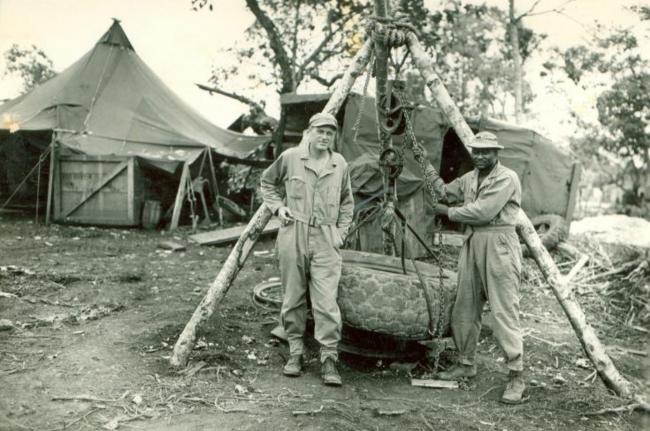
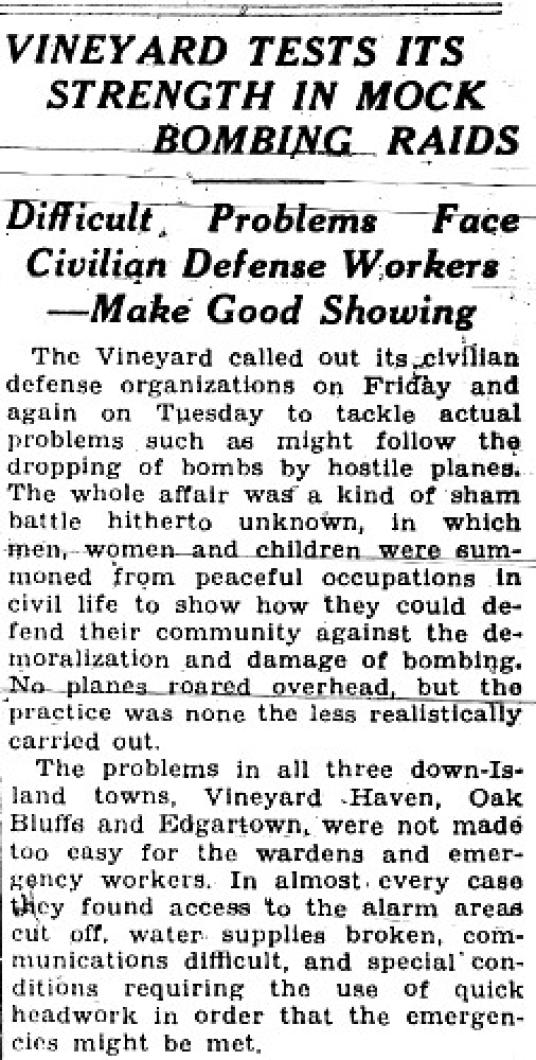



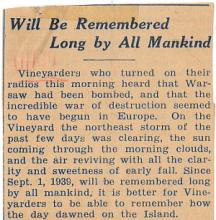
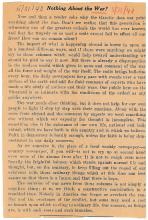

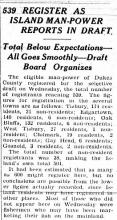

Comments